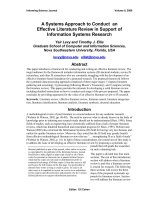Lecture A systems approach to small group interaction (8/e): Chapter 10 - Stewart L. Tubbs
Bạn đang xem bản rút gọn của tài liệu. Xem và tải ngay bản đầy đủ của tài liệu tại đây (1002.98 KB, 19 trang )
CCHH AAPP TT EE RR
10
Observing Group Process
Stewart L. Tubbs
McGrawHill
© 2004 The McGrawHill Companies, Inc. All rights reserved.
Slide 2
Observing Group Process
•
•
•
•
McGrawHill
Glossary
Case Study
Observation Instruments
The Systems Approach
© 2004 The McGrawHill Companies, Inc. All rights reserved.
Slide 3
Glossary
• Analyzing Group Process—a method for group
members to report their views of the group’s process.
• Functional Task Roles of Discussants—a
method of recording which group members made
comments that were taskoriented.
• Interaction Diagram—a graphic method for showing
who talks to whom in a group discussion.
• Participant Rating Scale Form—a method for
group participants to rate their group on a number of
different dimensions.
McGrawHill
© 2004 The McGrawHill Companies, Inc. All rights reserved.
Slide 4
Glossary
• Postmeeting Reaction Form—a method for
•
•
•
McGrawHill
allowing participants to assess their view of the group’s
effectiveness.
Progress Report on Group Interaction—a
method for measuring each group member’s perceptions of
a group meeting.
SelfCentered Roles of Discussants—a method
of recording which group members made comments that
were more self promoting than group promoting.
SocioEmotional Roles of Discussants—a
method of recording which group members made
comments that were more socially oriented. These
comments often build the group members’ feelings.
© 2004 The McGrawHill Companies, Inc. All rights reserved.
Slide 5
Glossary
• Team Diagnostic Questionnaire—a method of
determining a group’s strengths and weaknesses from the
viewpoint of the group members.
• The Collaborative Team LeaderLeader
Version—a method for team leaders to assess their own
group leadership effectiveness.
• The Collaborative Team LeaderTeam
Version—a method for team members to assess their
group leader’s effectiveness.
McGrawHill
© 2004 The McGrawHill Companies, Inc. All rights reserved.
Slide 6
Observation Instruments
• All of us benefit from periodic observation
and feedback.
• The instruments that follow are designed to
structure your observations in such a way as
to help you learn more about how your
group is performing.
McGrawHill
© 2004 The McGrawHill Companies, Inc. All rights reserved.
Slide 7
Observation Instruments
• AllPurpose Discussion Rating Scale
McGrawHill
© 2004 The McGrawHill Companies, Inc. All rights reserved.
Source: From Galanes, Adams, and Brilhart, 2000, p. 263.
Slide 8
Observation Instruments
• Interaction Diagram
McGrawHill
© 2004 The McGrawHill Companies, Inc. All rights reserved.
Source: From Wilson, 2002, pp. 29596.
Slide 9
Observation Instruments
• Functional Task Roles of Discussants
McGrawHill
Source: From Wilson, 2002, p. 298. Based on K.D. Berne and P. Sheats (1948).
© 2004 The McGrawHill Companies, Inc. All rights reserved.
Slide 10
Observation Instruments
• Functional SocioEmotional Roles of
Discussants
McGrawHill
Source: From Wilson, 2002, p. 301. Based on K.D. Berne and P. Sheats (1948).
© 2004 The McGrawHill Companies, Inc. All rights reserved.
Slide 11
Observation Instruments
• SelfCentered Roles of Discussants
McGrawHill
Source: From Wilson, 2002, p. 301. Based on K.D. Berne and P. Sheats (1948).
© 2004 The McGrawHill Companies, Inc. All rights reserved.
Slide 12
Observation Instruments
• Analyzing Group Process
McGrawHill
© 2004 The McGrawHill Companies, Inc. All rights reserved.
Source: From Huszczo, 1996, pp. 4748.
Slide 13
Observation Instruments
• Team Diagnostic Questionnaire
McGrawHill
© 2004 The McGrawHill Companies, Inc. All rights reserved.
Source: From Huszczo, 1996, pp. 4345.
Slide 14
Observation Instruments
• The Collaborative Team LeaderLeader
Version
McGrawHill
© 2004 The McGrawHill Companies, Inc. All rights reserved.
Source: From LaFasto and Larson, 2001, p. 151.
Slide 15
Observation Instruments
• The Collaborative Team LeaderTeam
Version
McGrawHill
© 2004 The McGrawHill Companies, Inc. All rights reserved.
Source: From LaFasto and Larson, 2001, p. 153.
Slide 16
Observation Instruments
• Postmeeting Reaction Form
McGrawHill
© 2004 The McGrawHill Companies, Inc. All rights reserved.
Source: From Galanes, Adams, and Brilhart, 2000, p. 267.
Slide 17
Observation Instruments
• Participant Rating Scale Form
McGrawHill
© 2004 The McGrawHill Companies, Inc. All rights reserved.
Source: From Galanes, Adams, and Brilhart, 2000, p. 267.
Slide 18
Observation Instruments
• Progress Report on Group Interaction
McGrawHill
© 2004 The McGrawHill Companies, Inc. All rights reserved.
Slide 19
The Systems Approach
• The most effective way to behave either as a
leader or as a participant in a group varies
with the type of group and the group’s
objectives.
McGrawHill
© 2004 The McGrawHill Companies, Inc. All rights reserved.









